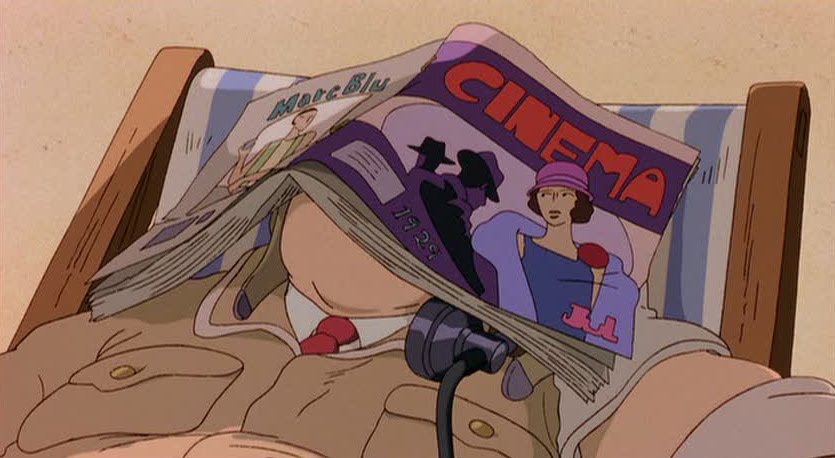The Honoraries: Hayao Miyazaki
 Thursday, October 30, 2014 at 8:30PM
Thursday, October 30, 2014 at 8:30PM Welcome to "The Honoraries" a daily miniseries honoring the careers of the three Honorary Oscar recipients of 2014 (Maureen O'Hara, Hayao Miyazaki, Claude Carriere) and the Jean Hersholt winner (Harry Belafonte). Here's Tim...

It’s annoying when people who already won competitive Oscars get tapped to receive an a Honorary award, as in the case of Hayao Miyazaki (his win was in 2002’s Best Animated Feature category, for Spirited Away, and it was hugely deserved). But, on the other hand, it’s Hayao Miyazaki. His body of work is among the strongest of any working director, and his recent retirement has caused a fundamental shift in the landscape of international animation. I can’t imagine anybody who has seen more than a couple of his films (or even just one, if it’s the right one), could possibly deny that his talent is of a magnitude that even two Oscars is… well, it’s “fine”, but maybe three would have been okay, too.
And for those of you who haven’t yet had the pleasure, I am happy to take this small chance to tell you what makes him so wonderful. Not by focusing on one film, as other entries in the Honoraries have done (but if you want my picks for The One You Have To See, it would be My Neighbor Totoro, Spirited Away, and Nausicaä of the Valley of the Wind, in that order. And that’s three, not one, but it’s Hayao Miyazaki), but by touching on some of the career-wide trends that have made all of his films, without exception, worthwhile and important and beautiful.
There Are No Bad Guys. Mostly. The first Studio Ghibli film, Castle in the Sky, does have a pretty clear-cut unreformed baddie. But everything else he’s made is ambiguous at least, and some of his best films have no antagonists at all. Generosity towards his characters is an absolute in Miyazaki’s filmography: the conflicts are not based on “these people are bad and wrong and must be beaten”, but on more ambiguous, sensitive depictions of how basically decent people can have conflicting goals. I’d say that more all-ages entertainment needs to understand that kind of simple, humane way of telling stories, but hell, all movies, regardless of audience, could do better on that score.

He’s Not Afraid of Girls. Miyazaki has directed eleven films, of which seven have either a female protagonist, or a boy/girl central pair (eight, if we count Princess Mononoke). There’s no track record anywhere else in animation that comes even slightly close to that, and they’re not just Generic Little Girls, but a wide range of personality types, backgrounds, and strengths, from Kiki the apprentice which to Nausicaä the warrior, to Satsuke and Mei, two ordinary children from Totoro.

He Loves Flight. Virtually all of Miyzaki’s films include at least one moment where his characters are freed from the ropes of gravity and simply soar and glide through the air (or water, in Ponyo). Two of his films are specifically about airplanes; several more involve sci-fi or fantasy flying contraptions. It is a clear passion for the director (whose swan song, after all, was the biography of an airplane designer), and it is the place where he completely gives in to the freedom and possibilities of animation. Not that Miyazaki films are ever short on breathtaking concepts and wonder, but it’s always the flight scenes where his films are at their most ethereal and imaginative and magical. It’s flight that takes My Neighbor Totoro from a charming fable to a miraculous depiction of childhood innocence; it’s flight that transforms Howl’s Moving Castle from a fine fantasy to an exciting, expansive adventure.

He Doesn’t Talk Down. The “animation is for children!” rule isn’t remotely as strong in Japan as in America, but even so, Miyazaki’s films overwhelmingly court a family audience. But whereas all but the most sophisticated films made in the States for children secretly or overtly assume that children are fragile morons, Miyazaki’s work crouches down to talk to children right at their level, and trusts them to understand things that can be troubling or hard.

Sick parents in Totoro; being alone and forced to count on your own strength in Spirited Away; taking responsibility for your actions in Kiki’s Delivery Service. There’s no pandering in any of these films, and no sticky nostalgia, just a very direct, honest assessment of what it feels like to be in childhood. And if there were nothing else about Miyazaki’s work to justify that Oscar, this absolutely sincere, unyielding honesty would be more than enough to do it.



Reader Comments (3)
Love this overview. though now it makes me feel guilty that Ihaven't seen his complete filmography. wish we had started the honorarys sooner.
I know! My Miyazaki experience has so many holes in it.
I'm always grateful, in an article like this, to get a list of starting points from a pro. So now I pledge to watch My Neighbor Totoro before Miyazaki accepts his honorary.
I've seen most of Miyazaki's films and they are treasures. The "lesser" ones are merely brilliant, and the best are spellbinding, all-time classics. My personal faves are Spirited Away, Porco Rosso (*), My Neighbor Totoro, Ponyo, and Howl's Moving Castle. A filmmaking genius!
(* With its quite unusual for Miyazaki middle-aged [half pig] hero, and vaguely realistic post-WWI Mediterranean setting, this is an atypically adult story for an animated film, and it isn't afraid to tell it straight: When the girl sidekick points out that Porco's a pig, he replies in downbeat noir style, "All middle-aged men are pigs.")